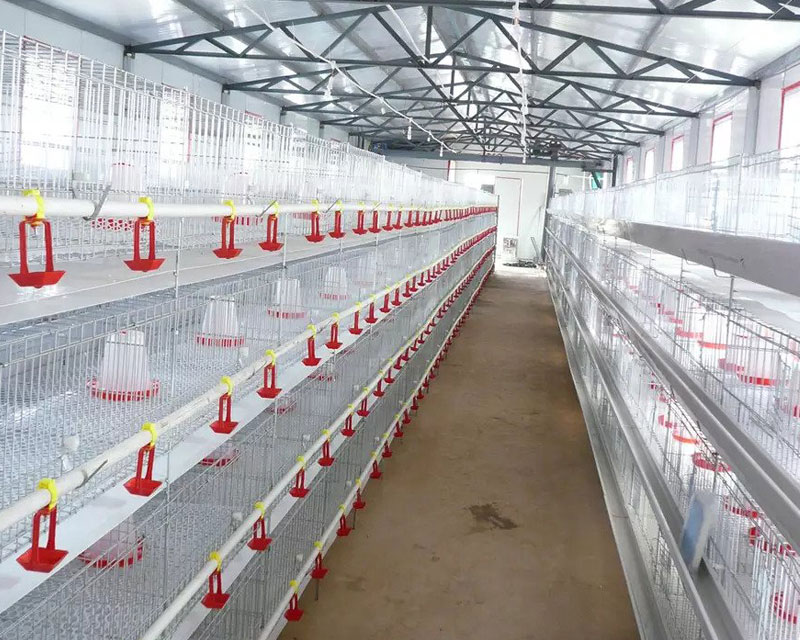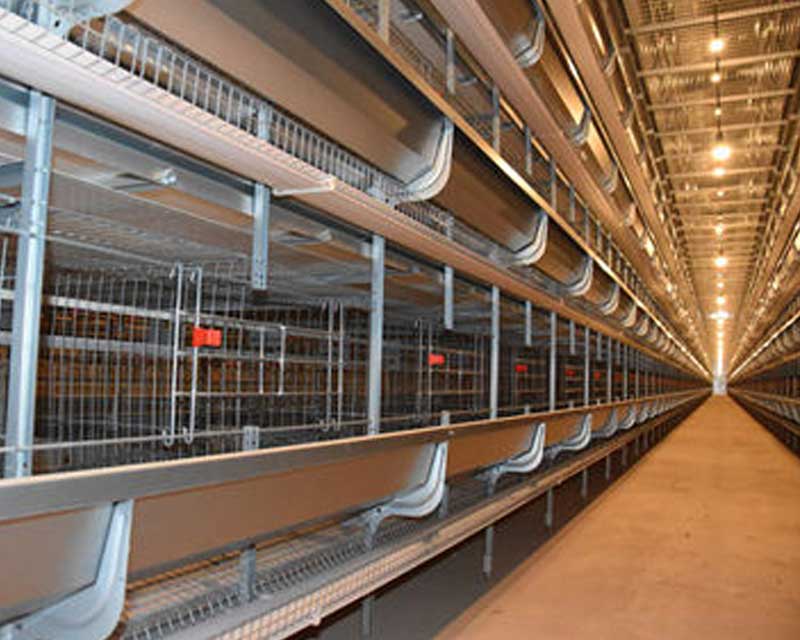Chicken Layer Cage Design Helps Improving Poultry Farming Efficiency
Introduction
Chicken layer cage design is a popular method of housing layers in modern poultry farming. It involves the use of specially designed cages that provide a comfortable and secure environment for layers to lay eggs. These cages are usually made of sturdy wire mesh and are designed to accommodate a specific number of birds per cage.
The use of chicken layer cages offers several benefits to farmers, including increased egg production, improved hygiene, and better disease control. By providing a controlled environment for layers, farmers can closely monitor the health and wellbeing of their birds, reducing the risk of diseases and infections. The cages also make it easier to collect eggs, reducing the risk of breakages and improving overall egg quality.
In addition to the practical benefits, chicken layer cages are also more space-efficient compared to other forms of housing. They allow farmers to house a large number of birds in a relatively small area, making them an ideal solution for commercial egg production. Overall, chicken layer cages offer an efficient and effective solution for modern poultry farming, providing a safe and comfortable environment for layers to thrive.
Cage Size and Dimension

The optimal size and dimension of chicken layer cages are crucial to ensure the health and wellbeing of layer birds. The size of the cage will depend on several factors, including the number of birds per cage, the size of the bird, and the type of layer production system being used.
In general, a well-designed chicken layer cage should provide adequate space for each bird to move around comfortably, stretch their wings, and access food and water. The recommended space requirement for layer birds is approximately 432 square inches per bird. This space allows the birds to exhibit natural behaviors such as perching, dust bathing, and nesting.
The dimension of the cage is also important to consider. The height of the cage should allow birds to stand upright and flap their wings without touching the ceiling. The width and length of the cage should be sufficient to provide easy access to feed and water, as well as easy egg collection.
Farmers should also consider the layout of the cages in the poultry house. The distance between the cages should be sufficient to allow for proper ventilation and prevent the spread of disease. Adequate space should also be provided for workers to move around the cages easily during daily maintenance and egg collection.
In summary, proper cage size and dimension are essential for the health and productivity of layer birds. Farmers must carefully consider the space requirements and layout of the cages to ensure the welfare of their birds and the success of their poultry farming operations.
Cage Material and Construction
The materials used in chicken layer cage construction play a crucial role in determining the durability and longevity of the cages. Commonly used materials for chicken layer cages include galvanized wire mesh, PVC-coated wire mesh, and plastic. Each material has its advantages and disadvantages, and farmers should carefully consider their options before selecting the material for their cages.
Galvanized wire mesh is the most commonly used material in chicken layer cages. It is durable and resistant to rust and corrosion, making it ideal for use in outdoor poultry houses. However, galvanized wire mesh can be heavy and difficult to work with, making it challenging to install and repair.
PVC-coated wire mesh is another popular option for chicken layer cages. It offers similar durability and rust resistance as galvanized wire mesh but is more lightweight and easier to handle. However, PVC-coated wire mesh is more prone to wear and tear, particularly in areas where the PVC coating has been damaged.
Plastic chicken layer cages are a newer development in the poultry farming industry. They are lightweight and easy to install, and their smooth surface is easy to clean and sanitize. However, plastic cages are more prone to cracking and breaking compared to wire mesh cages, particularly in extreme temperatures.

When constructing chicken layer cages, it is essential to consider factors such as ventilation, lighting, and temperature control. Proper ventilation is crucial to ensure good air quality and prevent the buildup of harmful gases such as ammonia. Adequate lighting is also necessary to encourage egg production and maintain the health of the birds. Additionally, temperature control is essential to keep the birds comfortable and prevent heat stress or cold stress.
In conclusion, the selection of the material for chicken layer cages and the construction of the cages play a critical role in the success of a poultry farming operation. Farmers must carefully consider the advantages and disadvantages of different materials and take into account important factors such as ventilation, lighting, and temperature control during cage construction.
Cage Accessories and Management
In addition to proper cage design and construction, accessories and management are critical factors in maintaining the health and productivity of layer birds. Some of the accessories required in chicken layer cages include feeders, waterers, perches, and nest boxes.

Feeders and waterers should be easy to access for the birds and designed to prevent waste and contamination. Perches provide a comfortable resting area for the birds and encourage natural behaviors such as roosting. Nest boxes should be designed to provide a private and comfortable area for egg-laying, encouraging the birds to lay eggs in a clean and easily accessible location.
Proper cage management is also crucial to maintaining the health and productivity of layer birds. Farmers must ensure that the cages are cleaned regularly to prevent the buildup of waste and harmful bacteria. Additionally, farmers must monitor the birds' health and behavior to identify and address any potential issues promptly.
Automation and technology integration have become increasingly common in modern poultry farming. Automated systems for feeding, watering, and egg collection can improve efficiency and reduce labor costs. Additionally, technology such as sensors and cameras can be used to monitor bird behavior and health, allowing farmers to identify potential issues and address them before they become significant problems.
In summary, accessories and management play a critical role in maintaining the health and productivity of layer birds. Proper cage design and construction, as well as regular cleaning and monitoring, are essential for the birds' welfare. Automation and technology integration can also help improve efficiency and reduce labor costs, making poultry farming more profitable and sustainable.
Biosecurity and Animal Welfare
Biosecurity is critical in preventing the spread of diseases among layer birds in chicken layer cages. Farmers must implement strict measures to prevent the introduction of pathogens into their flocks, including limiting access to the farm, using disinfectants, and proper waste management.
Animal welfare is also a crucial consideration in chicken layer cages. Farmers must ensure that their birds are provided with adequate space, clean water and feed, proper lighting, and a comfortable resting area. Additionally, farmers must monitor the birds' health and behavior and provide prompt treatment for any issues.
To maintain animal welfare in chicken layer cages, farmers should follow industry best practices and guidelines, such as those set by the World Organization for Animal Health (OIE) and the United States Department of Agriculture (USDA). These guidelines recommend providing adequate space per bird, monitoring and maintaining proper temperature and humidity levels, and using humane methods of euthanasia if necessary.
Compliance with animal welfare regulations is essential for farmers to operate their businesses sustainably and ethically. Failure to comply with animal welfare regulations can result in legal penalties, damage to the farm's reputation, and reduced profitability. Therefore, it is essential for farmers to stay up to date with current regulations and guidelines and implement appropriate measures to ensure the welfare of their birds.
In conclusion, biosecurity and animal welfare are crucial considerations in chicken layer cages. Farmers must take proactive measures to prevent the introduction of diseases and provide adequate care and treatment for their birds. Compliance with animal welfare regulations is essential for the long-term sustainability and profitability of poultry farming operations.
Conclusion
In conclusion, designing and constructing proper chicken layer cages is crucial for the welfare and productivity of layer birds. Key factors to consider include cage size and dimension, cage material and construction, cage accessories and management, biosecurity, and animal welfare.
Investing in quality chicken layer cages can help improve efficiency, reduce labor costs, and increase profitability in poultry farming operations. Farmers should also stay up to date with current regulations and guidelines related to animal welfare and biosecurity to ensure their operations are sustainable and ethical.
By implementing best practices in chicken layer cage design and management, farmers can provide a comfortable and healthy environment for their birds while maintaining productivity and profitability.

 4 Tier H Type Broiler Cage Project In South Africa
4 Tier H Type Broiler Cage Project In South Africa Layer Cage Project In Cuba
Layer Cage Project In Cuba H Type Layer Cage Project In Southeast Asia
H Type Layer Cage Project In Southeast Asia A Type Layer Cage Installed In West Africa
A Type Layer Cage Installed In West Africa Nigeria H Type Layer Cage Project
Nigeria H Type Layer Cage Project H Type Layer Cage Installed In Togo
H Type Layer Cage Installed In Togo